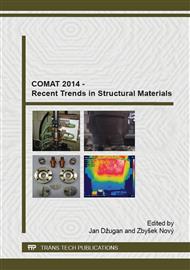p.55
p.61
p.67
p.73
p.79
p.85
p.91
p.99
p.107
Effect of Precipitation Aging Conditions on Microstructural Refurbishment in Cast Nickel Base Superalloy GTD-111
Abstract:
This research study has an aim to evaluate and investigate the effect of various rejuvenation heat treatments on microstructure of long-term serviced cast nickel base superalloy grade GTD-111 used as turbine blade material. The evaluated reheat treatment programs consist of solution treatment at 1195°C for 2, 3, 4 and 5 hours then following with primary aging at 1120◦C for 2 hours and secondary aging at 845°C for 25, 50, 75 and 100 hours, respectively. All reheat treated microstructures were examined and analyzed by SEM and image analyzer. From all obtained results, it was found that the most proper solution treatment duration was 5 hours to provide the most uniform microstructural characteristics, which consist of the uniform distribution of very dense gamma prime particles in the matrix as well as its highest hardness value. Furthermore, when increasing the duration at secondary aging at 845◦C over than 25 hours (which is according to standard heat treatment), such microstructure provided the most gamma prime phase stability comparing to those of other reheat treatment programs.
Info:
Periodical:
Pages:
79-84
Citation:
Online since:
October 2015
Price:
Сopyright:
© 2015 Trans Tech Publications Ltd. All Rights Reserved
Share:
Citation:


